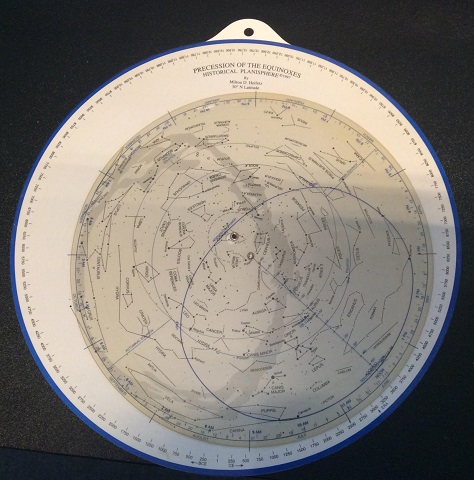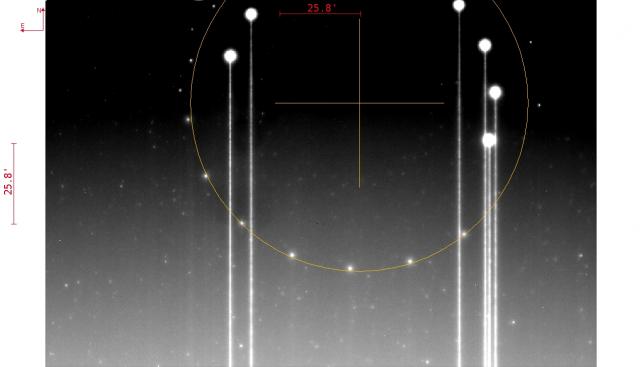- This topic has 9 replies, 6 voices, and was last updated 6 years, 9 months ago by
 Robert Ian Henderson.
Robert Ian Henderson.
-
AuthorPosts
-
18 March 2019 at 12:37 am #574284
 Dominic FordKeymaster
Dominic FordKeymasterA few weeks ago, I had an email from somebody asking whether it would be possible to build a variant form of planisphere to visualise the effect of the precession of the equinoxes.
I thought this was a really interesting idea. You just need to put the ecliptic pole at the centre of the planisphere, rather than the celestial pole, and then configure the planisphere to work for a latitude 23.5 degrees away from the north pole. The star wheel turns once every 25,772 years, rather than once every sidereal day.
Whereas a conventional planisphere projects the sky from RA and Dec to local Alt/Az, this kind of planisphere will project the sky from ecliptic coordinates to RA and Dec, using the same maths.
So, over the weekend I went about adapting the cut-and-stick planisphere kit I designed a few years ago to serve the purpose, and the result is here… https://in-the-sky.org/precession/
I’d be interested to know if anyone has seen anything like this before. With hindsight it’s quite an obvious thing to do, and a fun way to demonstrate how celestial coordinates change over time, though I’d never thought of it before!
18 March 2019 at 10:39 am #580865 David SwanParticipant
David SwanParticipantMaybe the BAA should establish a (very) long-term project where its members follow the movement of the celestial pole.
18 March 2019 at 11:45 am #580867 David SwanParticipant
David SwanParticipantCheers Paul. It does sound like a fun project that could be written up for a short report in the Journal. Perhaps when I have some spare time, I’ll follow your advice and look into this a bit more.
18 March 2019 at 5:10 pm #580869 Andrew DumbletonParticipant
Andrew DumbletonParticipant
I think I have a commercial version of such a planisphere. Written on it is the title ‘PRECESSION OF THE EQUINOXES, HISTORICAL PLANISPHERE (C) 1977 by Milton D. Heifetz, 30deg N Latitude. No idea where i picked it up, but if going to Winchester in a few weekends time, I could bring it with me if interested in its construction/operation? Or the attached image may suffice if the upload works. A little googling revealed this science shop item: https://shop.sciencefirst.com/astronomy-planetariums/3521-precession-of-the-equinoxes-classical.html
18 March 2019 at 7:16 pm #580870 Dr Paul LeylandParticipant
Dr Paul LeylandParticipantOk, let’s do it!
18 March 2019 at 10:24 pm #580872 Nick JamesParticipant
Nick JamesParticipantIf anyone wants to have a play I attach a couple of undriven images of the pole. One was taken when I was polar aligning my mount in Jan 2018, the other was taken tonight. They are both 600s exposures with the same camera/telescope and the FoV is 36×24 arcmin. The original FITS files are here.
19 March 2019 at 12:59 am #580874 Dr Paul LeylandParticipant
Dr Paul LeylandParticipantThanks Nick, they are beautiful.
When I get chance (not for a couple of weeks or more) I’ll write a circular-arc Hough transform to find the NCP in each image. Assuming it works well I’ll make the source code available here.
19 March 2019 at 7:03 am #580875 Nick JamesParticipant
Nick JamesParticipantHave fun with the images. That software routine would be very useful when polar aligning. I did this for my mount by imaging the pole undriven and then imaging the pole while slewing in RA. I needed to find the centre of the arcs and ended up printing the images and using a compass so something that did this automatically would be very helpful!
22 March 2019 at 1:42 pm #580890 Robert Ian HendersonParticipant
Robert Ian HendersonParticipantI did something similar (if cruder) in February to find out where my polar axis was pointing.
I took a sequence of images of the NCP region using a (shutterless!) Audine camera with a 135mm lens at f/3.5. The image shows the sum of 10 images taken 20 deg apart in RA.
The brightest stars in the field are Polaris ( dec = +89d 15m 50.56s ) and Lambda UMi ( +89d 02m 15.66s ).
Comparing with CdC, the centre of the circle is at about 15h 05m, +89d 53m 46s ( approx 6 arcmin E of NCP at the time). 22 March 2019 at 2:13 pm #580866
22 March 2019 at 2:13 pm #580866 Dr Paul LeylandParticipant
Dr Paul LeylandParticipantShould be easy enough to do. Point your scope at the celestial pole which is above your horizon. Take an hour-long exposure every month or two. Use your favourite astrometry software to find the centre of the star image arcs. Plot the results in a coordinate system where the start (or centre or end) of each arc is fixed. Precession is ~20 arcsec / year, easily measurable by anyone capable of arcsec precision. Note that this approach neglects the proper motions of the reference stars, which is likely to be accpetable onver the timescale of the project.
I’d try it but my fork-mounted scope can’t be pointed much above +75 Dec. That said, it might be a fun project for another scope which is (a) on an GEM and (b) not used for anything right now.
Thanks for giving me the idea!
-
AuthorPosts
- You must be logged in to reply to this topic.
